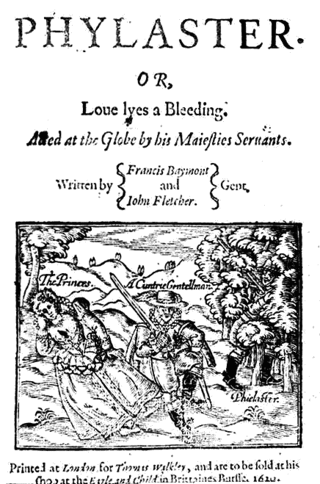Related Research Articles
Rollo Duke of Normandy, also known as The Bloody Brother, is a play written in collaboration by John Fletcher, Philip Massinger, Ben Jonson and George Chapman. The title character is the historical Viking duke of Normandy, Rollo. Scholars have disputed almost everything about the play; but it was probably written sometime in the 1612–24 era and later revised, perhaps in 1630 or after. In addition to the four writers cited above, the names of Nathan Field and Robert Daborne have been connected with the play by individual scholars.
The Birth of Merlin, or, The Child Hath Found his Father is a Jacobean play, probably written in whole or part by William Rowley. It was first performed in 1622 at the Curtain Theatre in Shoreditch. It contains a comic depiction of the birth of the fully grown Merlin to a country girl, and also features figures from Arthurian legend, including Uther Pendragon, Vortigern, and Aurelius Ambrosius.

Francis Beaumont was a dramatist in the English Renaissance theatre, most famous for his collaborations with John Fletcher.

Beaumont and Fletcher were the English dramatists Francis Beaumont and John Fletcher, who collaborated in their writing during the reign of James I (1603–25).

John Fletcher (1579–1625) was a Jacobean playwright. Following William Shakespeare as house playwright for the King's Men, he was among the most prolific and influential dramatists of his day; during his lifetime and in the early Restoration, his fame rivalled Shakespeare's. He collaborated on writing plays with Francis Beaumont, and also with Shakespeare on three plays.

The Maid's Tragedy is a play by Francis Beaumont and John Fletcher. It was first published in 1619.
Wit at Several Weapons is a seventeenth-century comedy of uncertain date and authorship.
Cupid's Revenge is a Jacobean tragedy written by Francis Beaumont and John Fletcher. It was a popular success that influenced subsequent works by other authors.
The Beaumont and Fletcher folios are two large folio collections of the stage plays of John Fletcher and his collaborators. The first was issued in 1647, and the second in 1679. The two collections were important in preserving many works of English Renaissance drama.

Philaster, or Love Lies a-Bleeding is an early Jacobean era stage play, a tragicomedy written by Francis Beaumont and John Fletcher. One of the duo's earliest successes, the play helped to establish the trend for tragicomedy that was a powerful influence in early Stuart-era drama.
The Honest Man's Fortune is a Jacobean era stage play, a tragicomedy written by Nathan Field, John Fletcher, and Philip Massinger. It was apparently the earliest of the works produced by this trio of writers, the others being The Queen of Corinth and The Knight of Malta.
Four Plays, or Moral Representations, in One is a Jacobean era stage play, one of the dramatic works in the canon of John Fletcher and his collaborators. Initially published in the first Beaumont and Fletcher folio of 1647, the play is notable both for its unusual form and for the question of its authorship.
The Elder Brother is an early seventeenth-century English stage play, a comedy written by John Fletcher and Philip Massinger. Apparently dating from 1625, it may have been the last play Fletcher worked on before his August 1625 death.
Beggars' Bush is a Jacobean era stage play, a comedy in the canon of John Fletcher and his collaborators that is a focus of dispute among scholars and critics.
Love's Pilgrimage is a Jacobean era stage play, a tragicomedy by Francis Beaumont and John Fletcher. The play is unusual in their canon, in that its opening scene contains material from Ben Jonson's 1629 comedy The New Inn.
The Woman Hater, or, The Hungry Courtier is an early Jacobean era stage play, a comedy by Francis Beaumont and John Fletcher. One of the earliest of their collaborations, it was the first of their plays to appear in print, in 1607.
Thierry and Theodoret is a Jacobean era stage play, a tragedy in the canon of John Fletcher and his collaborators that was first published in 1621. It is one of the problematic plays of Fletcher's oeuvre; as with Love's Cure, there are significant uncertainties about the date and authorship of Thierry and Theodoret.
The Captain is the title of a Jacobean era stage play, a comedy written by Francis Beaumont and John Fletcher. It was originally published in the first Beaumont and Fletcher folio of 1647.
The Noble Gentleman is a Jacobean era stage play, a comedy in the canon of John Fletcher and his collaborators that was first published in the first Beaumont and Fletcher folio of 1647. It is one of the plays in Fletcher's canon that presents significant uncertainties about its date and authorship.
The Mad Lover is a Jacobean stage play, a tragicomedy by John Fletcher. It was initially published in the first Beaumont and Fletcher folio of 1647. Fletcher's sole authorship was specified during the 17th century by his friend Sir Aston Cockayne. It displays Fletcher's distinctive pattern of stylistic and textual preferences throughout the text, so that his authorship is not questioned.
References
- ↑ David J. Lake, The Canon of Thomas Middleton's Plays, Cambridge, Cambridge University Press, 1975; pp. 192–7.
- ↑ Terence P. Logan and Denzell S. Smith, eds., The Popular School: A Survey and Bibliography of Recent Studies in English Renaissance Drama, Lincoln, NE, University of Nebraska Press, 1975; p. 74.
- ↑ Swapan Chakravorty, Society and Politics in the Plays of Thomas Middleton (Oxford, 1996), pp. 112-3.